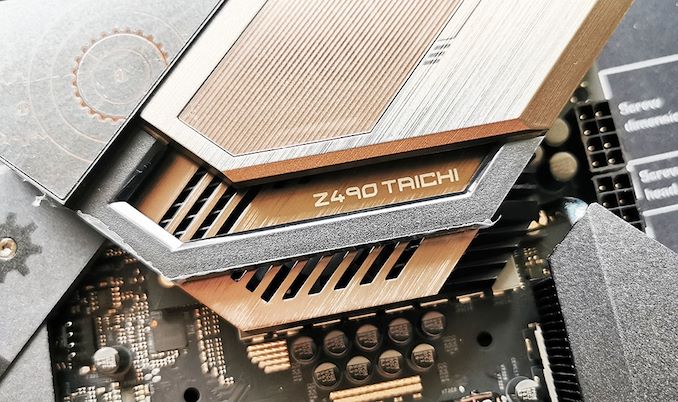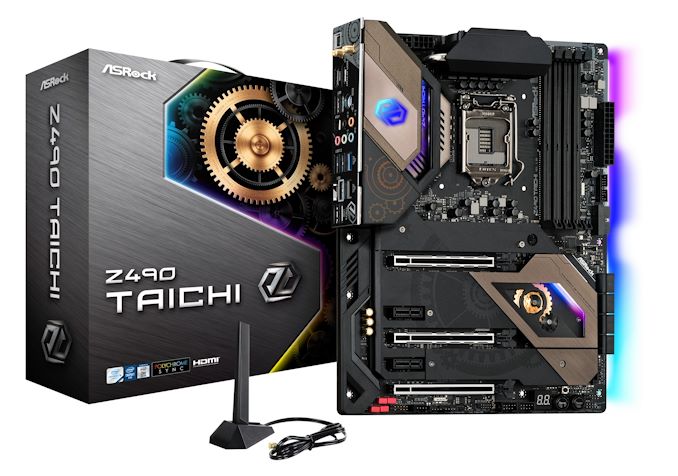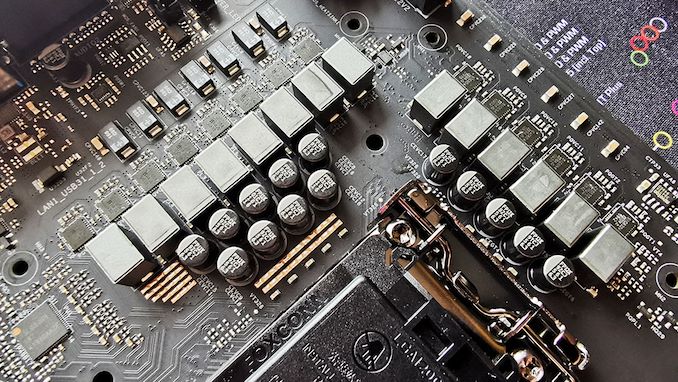The ASRock Z490 Taichi Motherboard Review: Punching LGA1200 Into Life
by Gavin Bonshor on May 27, 2020 9:00 AM ESTASRock Z490 Taichi Conclusion
The Z490 Taichi is the next interation in the Taichi series. It takes a premium position, currently just below the Z490 Aqua in which includes a large custom monoblock design for water-cooling. The ASRock Z490 Taichi therefore becomes a potential halo option for non-watercooled builts. The Taichi has a price tag of $370, which represents the mid to upper end of the Z490 chipset and includes some premium controllers with a unique Taichi inspired design.
Aimed at a mixed bag of users including gamers, content creators, and enthusiasts, the ASRock Z490 Taichi also includes future support for PCIe 4.0 and Intel's Rocket Lake processors through the top full-length PCIe x16 slot, and the top PCIe x4 M.2 slot. In total, the Z490 Taichi has three PCIe 3.0 x4 M.2 slots, with two that include support for SATA devices, as well as a total of eight SATA ports. Six of these are driven from the Z490 chipset with support for RAID 0, 1, 5, and 10 arrays, while the other two are present via an ASMedia ASM1061 SATA controller.
On the rear panel is a pretty stacked rear panel for a mid-range model with one USB 3.2 20 Gbps Type-C port which is one step down from Thunderbolt 3, while it also includes two USB 3.2 G2 Type-A, and five USB 3.2 G1 Type-A ports. BIOS Flashback is a handy feature to have, and ASRock includes boa DisplayPort 1.4 and HDMI video output pairing for users looking to use the integrated graphics on Intel's Comet Lake desktop processors. The Z490 chipset has also sparked an improvement in vendors networking capabilities, with the Z490 Taichi featuring a Realtek RTL8125BG 2.5 G and Intel I219-V Gigabit Ethernet controller pairing, as well as an Intel AX201 Wi-Fi 6 wireless interface which includes support for BT 5.1 devices.
When it came to performance and compared to other Z490 models, the ASRock Z490 Taichi is one of the most power-efficient models tested so far. Having revamped our motherboard test suite for Z490 in terms of benchmarks, the Z490 Taichi performed well; trading blows with other models on test with ease. It delivers the best DPC latency score from all of the Z490 models tested so far but does lack a little in terms of system POST times. The onus on manufacturers is to optimize its firmware and utilize Intel's V/F curve for improved turbo times, but not sacrifice too much in regards to heat and power. Overclocking performance is competitive too, and with a 12+2 phase power delivery running in 6+1 mode with doublers, it's more than capable enough of pushing Comet Lake as far as the silicon will allow, with adequate cooling methods, of course.
The ASRock Z490 Taichi has a lot of competition in the $350 to $400 price range, but it stands out as one of the unique Z490 models in terms of aesthetics. Rolling back the years a little, it is reminiscent of the ASUS Sabertooth series with its PCIe slot armor, and features as much plastic, which is a bit disappointing. The rear panel cover is plastic, and for $370, it wouldn't hurt ASRock to bolster the overall premium feel of the board with more metal, less plastic. Aside from this, it looks a solid and competitive Z490 option.













57 Comments
View All Comments
Ian Cutress - Wednesday, May 27, 2020 - link
I still have a DDR booster :)YB1064 - Thursday, May 28, 2020 - link
Happy to take it off your hands if you don't need it. :)bigboxes - Wednesday, May 27, 2020 - link
It's funny, you had me up until DFI. I had a lan party NF4 board. I hated that thing. It was too difficult to get and keep stable. I wasn't a noob when it came out. Such a disappointment. I like tweaking my stuff, but no thanks. LolSpunjji - Thursday, May 28, 2020 - link
Can second this. The LAN party NF4 boards were absolute garbage - I had a friend RMA the same one twice, and the entire process took a year. What's the point of having the best OC features if your boards aren't stable at stock settings?alufan - Thursday, May 28, 2020 - link
And third garbage wouldnt overclock worth Toffee even running stock was a challenge all they had was fancy colours and a lot of rave reviewsYB1064 - Thursday, May 28, 2020 - link
I never said that the DF4 boards were reliable. They were at best betas, but I'll be damned if they didn't overclock like crazy. I've gone through about ~20 boards (NF4, NF4-SLI-DR, NF4-Expert) to find the best ones. It was a crapshoot, but man was it FUN!andanand - Wednesday, May 27, 2020 - link
Is there any reason someone would choose an i7 over an AMD cpu at the same price point?lmcd - Wednesday, May 27, 2020 - link
Microsoft still hasn't gotten around to nested Hyper-V on AMD -- unless it quietly made it into 2004 that released today.IGP is pretty useful on Linux still since AMD driver support tends to be late for new graphics architectures. A CPU-only workload on Linux would definitely favor Intel, as cheap AMD GPUs are ancient and Nvidia proprietary drivers are still annoying to use.
lmcd - Wednesday, May 27, 2020 - link
Nested Hyper-V sounds niche but anyone who wants to use the Windows 10X emulator needs it unfortunately.mooninite - Wednesday, May 27, 2020 - link
Hi, let's calm down on the FUD.You act like the only virtualization solution on Windows is Hyper-V. It's not. It's not a deal breaker for most people. Maybe for you... but not for most people.
IGP support is *equal* today (yes, the year is 2020) with Intel and AMD IGPs. All the way up to Ice Lake and Vega 3xxx APUs. Performance favors AMD IGPs. This support extends to video decoding and encoding, which is equal on both sides.
The NVIDIA driver is painless to use if you use a sane, well-maintained distribution that packages it for you.
Anything else you would like to debate? Some of your statement was true a decade ago, but times have changed for the better.